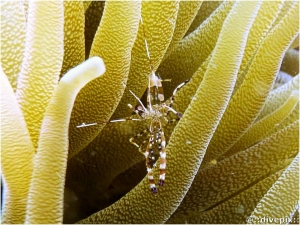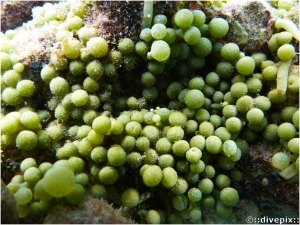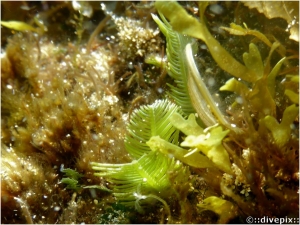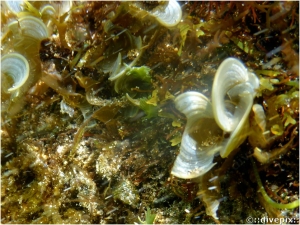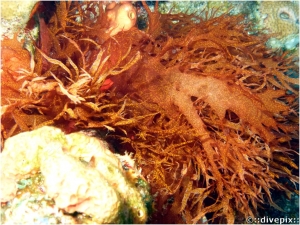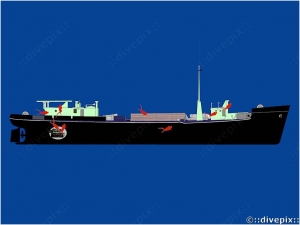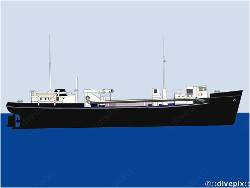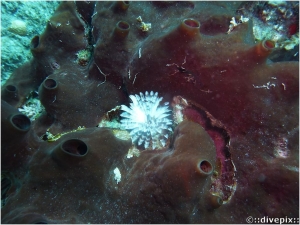




Daniel H. Biass
Three-Finger Leaf Alga or Three Leaf Finger
| Aspect: | Green upright stem from which tightly branch out multiple lobed leave-bearing sub-branches. |
| Population: | Occasional. |
| Notable feature: | Very high calcium content, to the extent of contributing to the local seabed composition when dead. |
| Environment: | Usually found in sandy bedded shallow waters in company of sea weeds as exemplified by the picture herewith. |
| Behaviour: | . |
Spotted Cleaner Shrimp
| Aspect: |
Brown and white dominantly coloured shrimp, with banded front legs and light brown-and-white roundel-adorned tail and long brown-banded white antennae. Body itself is tranlucid with tiny purple dots, main white legs are brown-banded and tipped with blue/purple claws while other legs are purple-banded white. |
| Population: | Common. |
| Notable feature: | May be mistaken for the smaller Squat Anemone Shrimp (q.v.), which has much shorter antennae and far more discrete legs. |
| Environment: | Typically found in giant anemones. |
| Behaviour: | Will usually try to hide if approached too closely. |
Green Grape Alga (a.k.a Sea Grape)
| Aspect: | Grape-like assembly of green beads attached to a thin stem, itself attached to a semi-hidden rhizome. . |
| Population: | Occasional. |
| Notable feature: | Grapes are spaced about every few centimetres (3 to 5) along the rhizome. |
| Environment: | Usually found in shallow waters. |
| Behaviour: | - |
Tubular Thicket Alga sp.
| Aspect: | Pink, dense growth of dichotomously growing tubular branches. Most branches endings are Y-tipped |
| Population: | Common. |
| Notable feature: |
Due to the fact that the branches are calcified and therefore rigid, it is easy to instinctively take this for a some variety of tubular worm. Not to be confused with much nimbler Pink Segmented Alga. |
| Environment: | Usually found in shallow, quiet waters. |
| Behaviour: | - |
Divers
Under normal circumstances, diving is not dangerous if all rules are well observed, but there always is a risk that Murphy will cut in to wreck havoc. This is why the absolute rule is never to dive on one’s own, which in itself intuitively dictates a feeling of mutual trust with one’s diving buddy. Mutual because even if a lesser experienced diver will always seek the company of an experienced buddy, the experienced diver will too think twice about diving again with someone whose behaviour under the surface can be questioned.

A Couple of Dos and Don’ts
Before we move on to this display of divers, and in the light of what was said above, it might be appropriate to provide two examples of dos and don’ts.


 This lady is the exception that confirms the rule. This relative beginner had just pocketed her advanced open water certificate and showed fine self-control as she exited a wreck, removing the regulator from her mouth to greet the photographer.
This lady is the exception that confirms the rule. This relative beginner had just pocketed her advanced open water certificate and showed fine self-control as she exited a wreck, removing the regulator from her mouth to greet the photographer.
(Those who wish to have their pictures removed please click here, and state you name, adding “remove”)
Green Feather Alga
| Aspect: | Light green feather-like blade growing vertically from sandy bottom-concealed horizontal rhizomes. |
| Population: | Common. |
| Notable feature: | Branches of the "feathers" are round and grow uppwards. |
| Environment: | Usually grow on sandy bottoms in shallow, quiet waters. |
| Behaviour: | - |
White Scroll Alga
| Aspect: | Grey-white semi-circular curled white blades. |
| Population: | Common. |
| Notable feature: | Blades horizontally crossed by darker lines. |
| Environment: | Usually found in shallow, quiet waters. |
| Behaviour: | - |
Serrated Strap Alga
| Aspect: | Orange-brown bunch of wide, flat blades with serrated edges and dichotomously forking tips. Blade width within a same clump can vary considerably. |
| Population: | Common. |
| Notable feature: | Close-up views reveal a moiré pattern on alga blade surface. Totally irregular shape. |
| Environment: | Rocky slopes exposed to currents. |
| Behaviour: | - |
Franjack
The Franjack was carefully prepared to offer both an attractive, safe exploration site and a home to underwater wildlife development and thereby dilute diver concentration away from the Ilets Pigeon, together with the not too distant Augustin Fresnel II and Gustavia wrecks.
Preparation included removal of all elements that could cause involuntary entrapment, particularly the lifeboats and their davits, doors and hatches and conversely improve easy access to its internal volumes. The dredging pipes are also gone and only the scavenge pipe on starboard lies, collapsed on the gunwale.
Items that must have been added at a later stage, but that do not feature on the drawings, are a couple of cantilevered arms crudely made of welded “I” beam overhanging the rear starboard area, and a curious aerial array of railings at either end of the cargo hold, which works as a heavenly home to numerous varieties of fish.
Of particular interest is the engine room, which can be accessed either vertically through a cut-out in the aft quarters roof behind the place where the funnel used to be, or through the door at the front of that part of the structure, or from its side-doors.
 While the front mast stands up and proud, the aft mast, an inverted "Y" (so think of that letter standing upside-down), is folded horizontally over the roof, resting on its two original supports, but its upper section was lost. This section, between the roof and the folded mast, is home to a dense colony of snappers and grunts of all kinds.
While the front mast stands up and proud, the aft mast, an inverted "Y" (so think of that letter standing upside-down), is folded horizontally over the roof, resting on its two original supports, but its upper section was lost. This section, between the roof and the folded mast, is home to a dense colony of snappers and grunts of all kinds.
Shortly after she was sunk, the Franjack lost most of her bridge to a violent storm and only the rear bulkhead of that structure survives to date.
The MaK engine is an impressive affair, which can be best examined from its starboard side.
The rocker covers have been dismantled to reveal the valve springs and gear, while lower, at crankshaft level, the ports in the block have been removed to display the piston skirts and their conrods. A quick glance upwards in the chambers will reveal air still trapped in the upper block! The pistons are over 30cm in diameter, so think of six long-playing vinyl records moving up and down 45 cm to produce a displacement of some 66 litres, generating 800 horsepower at the furious speed of 330 rpm!
A visit to the lower bow will show that the Franjack did not plough deep into the sand, but astern, the half dug-in three-blade screw suggests that another good metre of metal lies below the sand surface.
Dive safely!!!
History:
A most popular wreck due to both its low depth an proximity from the shore – almost within swimming distance of the Atlantis diving club on the road between the Malendure Rock and Pigeon – the Franjack was a sand dredger that started life as the Oresund at the Danyard Danish shipbuilders. Named after the strait separating Denmark and Sweden and launched on 1 January 1965, she first operated around Copenhagen, then changed name to Franjack in July 1976 when she was acquired by a company to operate around the French port of La Rochelle in the 1970s before being again taken over and overhauled in Fort de France (in Martinique) by a Gosier-based operator in Guadeloupe.
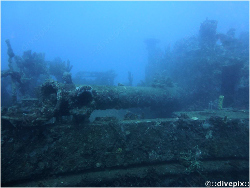 Deemed beyond repair and abandoned in a corner of Pointe-à-Pitre harbour after the devastating Hugo hurricane in 1989 she was finally cleaned up of any noxious elements and scuttled in 1996. While the side dredge was removed, one of the scavenge pipes survives on port.
Deemed beyond repair and abandoned in a corner of Pointe-à-Pitre harbour after the devastating Hugo hurricane in 1989 she was finally cleaned up of any noxious elements and scuttled in 1996. While the side dredge was removed, one of the scavenge pipes survives on port.
Description:
The Franjack lies flat and horizontal on her keel on a sand bed at a depth of 24 metres, with her centre deck about 3 metres higher and making the aft cabin roof lofting under about 18 metres of water. This, added to the fact that her forward mast towers at a mere 10 metres below the surface, the Franjack is also very popular with apneists.
The lower “inverted Y” section of the aft mast is folded backwards over the rear cabin roof (both masts were foldable to pass under bridges). On that roof, a plate of ample dimensions ahead of the emplacement of the oblong-based funnel was removed to give easy and direct vertical access to the engine and its room. The funnel itself is gone. The big horn ahead of where the funnel was, is a later fitment, perhaps during the Fanjack’s mid-life update at la Rochelle.
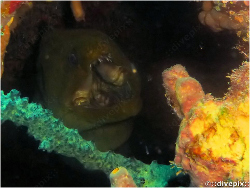 The Franjack wreck is home to an amazing number of coral, anemone, sponges and fish species, and particularly to a pretty large green moray that may be found either in the large scavenge pipe lying across the port gunwale or in a hollow section of the ship further aft.
The Franjack wreck is home to an amazing number of coral, anemone, sponges and fish species, and particularly to a pretty large green moray that may be found either in the large scavenge pipe lying across the port gunwale or in a hollow section of the ship further aft.
The bridge collapsed after a strong storm in the mid-2000s and only the lower and after structure of this survived. It looks odd, but the asymmetrical physiognomy of this aft section actually is original.
The state of the Franjack has started to noticeably deteriorate around 2012, and it may sooner or (hopefully) later be hazardous to visit the deck-level compartments whose access gallery surround and overlook the engine room . Even parts of the hull where it rests on the sand are showing signs of buckling.
Builder: Frederikshavns Vft, Frederikshavn, Denmark
Original name: Øresund
Gross Tonnage: 486
Length: 53.3 metres
Beam: 10.03 metres
Height (keel to deck): 3.35 metres
Screw: 1
Engine: one 800hp, 66-Litre MaK 6MU451 six-cylinder (in line), four-stroke diesel.
Brown Encrusting Octopus Sponge
| Aspect: | Brown elongated leathery structure with randomly emplaced excurrent chimneys. Often branches out like octopus tentacles. |
| Population: | Common. |
| Notable feature: | Excurrent openings have thin brims and look like inverted funnels. |
| Environment: | Has no particular growing area or condition. Can overhang or rest on a rock. |
| Behaviour: | . |




